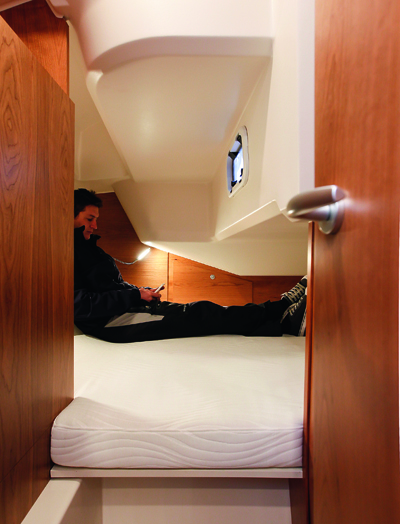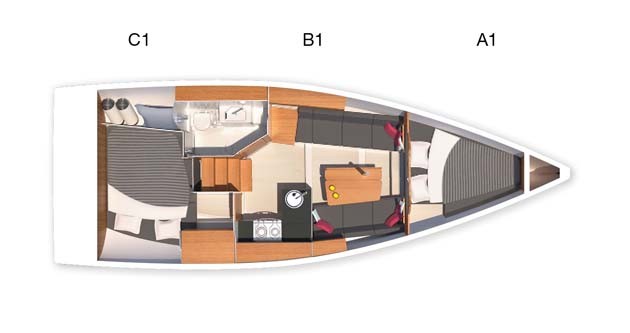As other builders go up in size, Hanse looks to the smaller end of its fleet to bring in the customers. And the Hanse 315 packs a lot in a small space, says Toby Hodges
Hanse 315 boat test – packing a lot into a small space
Winner of the Family Cruiser category of the European Yacht of the Year Awards 2015. Read more here
What do Tesco Metro, iPad Mini and a Hanse 315 all have in common? They are the result of big firms concentrating the best of their products into a more compact, feature-rich, yet user-friendly version.
Take Tesco, UK’s biggest superstore chain. Its success, from the 1980s to today, is linked with its ability to adapt quickly to consumer trends using the size, range and variety of its stores. Its smaller, compact Metro branches, which first appeared in 1994, are a clever example of the company’s versatility.
Hanse Yachts was founded at around the same time (early 1990s) and soon developed a wide range of modern production cruising yachts with broad appeal. But recently you could be forgiven for thinking that its success with large yachts would tempt the Greifswald yard to focus on the top end of the scale. Hanse has sold over 175 of the 575 in three years, and has taken six orders for the yet-to-launch 675.
However, Hanse’s 315 shows that keeping equal focus on the smaller sizes is smart. It attracts people into a brand where, as with supermarkets, retaining loyalty becomes key.
The same applies to other large yacht builders, so why should you be interested in this particular 30-footer? In my opinion, the Hanse 315 is the best recent example of a compact big yacht. It takes many intelligent ideas seen on larger modern designs and includes them in a size that is both practical and fun to sail.
The 315 has more volume than the 325 it is replacing, a larger sailplan and deeper L-keel (providing CE category A). As Tesco’s Metro branches have done to larger stores, Hanse’s 315 could render many larger yachts obsolete.
The shape of things to come
Many of the best features of the 315 stem directly from her hull shape. Judel Vrolijk has given her a modern performance profile that closely resembles that of her sister brand Dehler. Benefits from this shape are felt in the cockpit space and generous volume aft. Broad aft beam creates the option of twin wheels – she’s the smallest production yacht to have this.
But the prime advantage of her hull design, the calling card of the 315, is her superb sailing ability. It is the reason why I wanted a second sail after a brief autumn outing during the European Yacht of the Year trials.
Her flared quarters look aggressive and, together with a near plumb stem and stern, help maximise waterline length when heeled. The result is that she is simply a delight to sail, aided by steering that is superlight and responsive.
The 315 is a surprisingly addictive boat to helm. Most yachts take some getting used to, as you try to get the balance right, tweaking the control lines. The Hanse is instantly playful, encouraging you to throw her through tacks and maximise your time on the water.
UK agent Phil Dollin thought a reef or two might be prudent with the wind gusting over 20-25 knots as we left the Hamble River. But with flat water and an interest in seeing how she responds when pushed, he agreed to keep full sail. It helped to demonstrate how manageable this 30-footer is.
Advantages of a self-tacking jib
The 315 brings sailing back to basics, thanks in part to her single-point mainsheet and a self-tacking jib. Admittedly, there were times when Dollin needed to play the main as we headed into chop and Force 6 gusts around Calshot, or when I would feather the main if I were sailing her solo. But she only rounded up once, ever so politely, when over-pressed.
The vang and backstay are sufficiently adjustable to flatten the large main to keep it driving rather than overpowering the boat.
The self-tacking jib helps make sailing smooth and easy. It also aids confidence, especially with the breeze up. Instead of gybing, for example, you can just throw in a handbrake turn – a 270° tack – which only requires the helmsman to spin the wheel.
One problem we found when doing this with the single-point mainsheet was that it can get caught on the (optional) primary winches when it goes slack.
I was surprised to hear that few Hanse owners in the UK opt for a downwind sail. A furling asymmetric at least would top my extras list to help compensate for the small headsail area and its poor sheeting angle when sailing deep – the narrow width of the track is dictated by the coachroof to which it is mounted.
I would also welcome the ability to trim the jib from the wheel, by creating a lead from the coachroof to a primary. For couples, or those intending to sail solo, the standard tiller steering might be a more practical option for adjusting main and jib trim.
The Hanse 315 is sprightly and spirited to sail, particularly upwind and close reaching. We averaged around 7 knots close-hauled, where 32° to the apparent wind (45° true) was the sweet spot. Pinch more and the mainsail loses power and speed drops off quickly.
Reaching speeds touched 8 knots, well heeled – nothing to get worried about, just enough to give a safe thrill. The twin wheels help maintain the sporty feel with direct feedback via Jefa linkage.
The down sides of entry-level
Building a compact cruising yacht with a wealth of positive features for an entry-level price invariably involves drawbacks.
The pushpit is the first downside I took issue with. Hanse offers a beamy swim platform, above which is just a single guardwire to protect the cockpit. We were quick to point out this safety deficiency during our trials of an early 315 model in La Rochelle.
During those same trials, the fitting supporting the optional genoa sheet arrangement became detached – it turns out there was no backing plate below the deck. Hanse has since addressed both problems on later models.
The starboard steering column on the Hanse test boat in the Hamble also had play in it and it felt as if the mounting needed better reinforcement. Hanse commendably builds ten prototypes at this size, but these are issues that should be seen and resolved before production begins in earnest.
The test boat had a lot of optional extras, including an upgraded engine, twin wheels, laminate sails, sprayhood, heating, etc. It served as a good example of how the finish price of a production yacht bears little resemblance to its base price. With everything included, the test boat cost double the £50,000 standard price.
Looking through the spec sheet, I’d still want an offwind sail as well – and, having seen one hull in metallic blue, perhaps even a vinyl wrap.
Standing room
Pause at the foot of the companionway and you’ll notice something rather unusual for a yacht of this size – you can stand. By lowering the sole to the minimum height above the bilge, Hanse has created 6ft 3in headroom here.
This has a greater impact than you might imagine; it really gives the impression of a much larger yacht below. You can stand to work at the galley or chart table. The only problem is that you soon forget you are on a 31ft yacht, and promptly bump your head when going forward.
The layout is beautifully in proportion. The design team has been particularly clever with the cabins. Rather than just have a vee berth and open bulkhead forward, they have created an option for a cabin with a door. To achieve this, the length of the berth is reduced and insert boards used each side aft. This creates three different options: a child’s berth, a single berth with changing seat, or a full double vee berth.
However, it is the aft cabin that will be used by owners – if they can get into it. The entrance is short and narrow, but once there, you are rewarded with a giant athwartships double berth that extends under the cockpit.
It is wide enough, in fact, to be used as a longitudinal single berth should you want to. An angled backrest against the hull encourages you to recline comfortably in the area with most seated headroom.
The port saloon sofa is long enough to sleep on and the saloon is generous in size. Although the heads is also large, it feels rather bleak. It’s simply a wet room, a glassfibre pod that brings home the mass-production nature of the build. But there is plenty of light and 6ft headroom and it puts practicality first, including space to hang wet weather gear over the shower tray.
Hanse owners can escape the ‘cloned’ feel to some extent thanks to the numerous options on offer. There is a multitude of colour options inside and out, including gelcoat tints or vinyl wraps, upholstery and veneer finish. I was impressed to see big boat features as standard too, such as LED lights that can be dimmed or controlled from a smart touch panel.
As Tesco’s slogan says: ‘Every little helps.’

 Specifications
Specifications
LOA 9.62m/31ft 7in
LWL 8.70m/28ft 7in
Beam (max) 3.35m/10ft 11in
Draught 1.85m/6ft 1in
Disp (lightship) 4,700kg/10,362lb
Ballast 1,500kg/3,307lb
Sail area (100% foretriangle) 49.8m2/563ft2
Berths 4-5
Engine 11.8hp Volvo Penta saildrive
Water 230lt/51gal
Fuel 160lt/35gal
Sail area:disp 19.0
Disp:LWL 199
Price ex VAT: £54,092
Price as tested: £99,195 inc VAT
Design: Judel/Vrolijk & Co
Conclusion
Be realistic, how many large cruising yachts would you really want to take out for a quick spin, two-up? I don’t know of many that I could or would want to do what we did during our test sail: hop aboard for a photoshoot, throw her around and sail her solo at times while over-canvassed. Yet the Hanse 315 was a joy, despite the dull winter conditions.
The price might not be quite as attractive as it might seem at first glance – not exactly ‘entry level’ by the time you’ve ticked enough boxes to make the boat comfortable – but the 315 still represents good value.
There were a few concerns with build quality on deck, signs that Hanse is perhaps cutting corners to keep cost down, but this is related to the larger issue of trying to create a truly affordable new yacht.
That aside, if you want a small family cruiser or a sporty, compact yacht, look no further. The Hanse 315 has the space and pace of a 35-footer with the price and practicality of a 30-footer. She puts the basics back into enjoyable sailing. Light and manageable, easy and fun, she has a shape that ensures an entertaining ride.
When done well, it is the convenience of a compact model, whether that be electronics, supermarkets or cruising yachts, that attracts the customers to come back.











